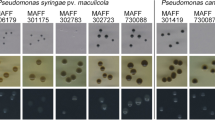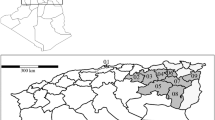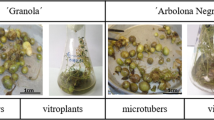Abstract
Onion bacterial blight, caused by Xanthomonas sp., is a potentially severe disease in several tropical and subtropical areas. Although little research has been undertaken on this pathosystem, seed transmission of the pathogen has been hypothesized. Because of an important bacterial microflora naturally associated with onion seeds, detection of the pathogen is difficult using non-selective agar media. A new semi-selective medium, whose selectivity was obtained by a combination of four antibiotics, was developed. The new NCTM1 medium contained (per liter) yeast extract 7 g, peptone 7 g, glucose 7 g, agar 15 g, neomycin 10 mg, cephalexin 30 mg, trimethoprime 3 mg, pivmecillinam 100 mg and propiconazole 20 mg. Plating efficiencies, using 16 pure cultures of the pathogen, ranged from 79% to 142%, with an average of 110% compared to the basal medium. All onion Xanthomonas sp. strains from several countries grew on NCTM1 medium. The pathogen was repeatedly isolated using this medium from seed samples containing approximately 106 saprophytic bacteria per gram, as well as from symptomless plant material. Xanthomonas sp. was detected only in seeds originating from one infected seed production site. This is the first report of selective isolation of Xanthomonas sp. from onion seeds. NCTM1 medium should be a valuable tool to study the ecology and epidemiology of Xanthomonas sp. causing onion bacterial blight.
Similar content being viewed by others
References
Acar JF and Goldstein FW (1991) Disk susceptibility test. In: Lorian V (ed) Antibiotics in Laboratory Medicine (pp 17-52) Williams & Wilkins, Baltimore
Aggour AR, Coyne DP, Vidaver AK and Eskridge KM (1989) Transmission of the common blight pathogen in bean seed. J Amer Soc Hort Sci 114: 1002-1008
Alvarez AM, Buddenhagen IW, Buddenhagen ES and Domen HY (1978) Bacterial blight of onion, a new disease caused by Xanthomonas sp. Phytopathology 68: 1132-1136
Barry AL (1991) Procedures and theoretical considerations for testing antimicrobial agents in agar media. In: Lorian V (ed) Antibiotics in Laboratory Medicine (pp 1-16) Williams & Wilkins, Baltimore
Bochner BR (1989) Sleuthing out bacterial identities. Nature 339: 157-158
Bowen P, Gibbs HAA and O' Garro LW (1998) Garlic, chives, challot and leek are alternative hosts to Xanthomonas campestris, the pathogen of leaf blight of onion Allium cepa L. In: Proceedings 7th International Congress Plant Pathology, Edinburgh, Scotland
Bryan LE and Godfrey AJ (1991) β-lactam antibiotics: mode of action and bacterial resistance. In: Lorian V (ed) Antibiotics in Laboratory Medicine (pp 599-664) Williams & Wilkins, Baltimore
Civerolo EL, Sasser M, Helkie C and Burbage D (1982) Semiselective medium for Xanthomonas campestris pv. pruni. Plant Dis 66: 39-43
Claflin LE, Vidaver AK and Sasser M (1987) MXP, a semiselective medium for Xanthomonas campestris pv. phaseoli. Phytopathology 77: 730-734
Davis MJ, Rott P, Baudin P and Dean JL (1994) Evaluation of selective media and immunoassays for detection of Xanthomonas albilineans, causal agent of sugarcane leaf scald disease. Plant Dis 78: 78-82
Dhanvantari BN and Brown RJ (1993) YSSM-XP medium for Xanthomonas campestris pv. phaseoli Can J Plant Pathol 15: 168-174
Di M, Ye H, Schaad NW and Roth DA (1991) Selective recovery of Xanthomonas spp. from rice seed. Phytopathology 81: 1358-1363
Dye DW, Bradbury JF, Goto M, Hayward AC, Lelliott RA and Schroth MN (1980) International standards for naming pathovars of phytopathogenic bacteria and a list of pathovar names and pathotype strains. Rev Plant Pathol 59: 153-168
Eliopoulos GM and Moellering RCJ (1991) Antimicrobial combinations. In: Lorian V (ed) Antibiotics in Laboratory Medicine (pp 432-492) Williams & Wilkins, Baltimore
Fessehaie A, Wydra K and Rudolph K (1999) Development of a new semiselective medium for isolating Xanthomonas campestris pv. manihotis from plant material and soil. Phytopathology 89: 591-597
Fukui R, Arias R and Alvarez A (1994) Efficacy of four semiselective media for recovery of Xanthomonas campestris pv. campestris from tropical soils. J Appl Bacteriol 77: 534-540
Isakeit T, Miller ME, Barnes LW, Dickstein ER and Jones JB (2000) First report of leaf blight of onion caused by Xanthomonas campestris in the Continental United States. Plant Dis 84: 201
Jalenques F (1988) Dénombrement rapide de colonies microbiennes par le 'système Spiral'. Inf Tech Biol 1: 13-16
Kritzman G (1991) A method for detection of seedborne bacterial diseases in tomato seeds. Phytoparasitica 19: 133-141
Mabagala RB and Saettler AW (1992) An improved semiselective medium for recovery of Xanthomonas campestris pv. phaseoli. Plant Dis 76: 443-446
Masmoudi K, Duby C, Suhas M, Guo JQ, Taylor JD and Maury Y (1994) Quality control of pea seed for pea seed-borne mosaic virus. Seed Sci Technol 22: 407-414
McGuire R, Jones JB and Sasser M (1986) Tween media for semiselective isolation of Xanthomonas campestris pv. vesicatoria from soil and plant material. Plant Dis 70: 887-891
Neu HC (1991) Bacterial resistance to other antibacterial agents. In: Lorian V (ed) Antibiotics in Laboratory Medicine (pp 714-722) Williams & Wilkins, Baltimore
Norman DJ and Alvarez AM (1994) Rapid detection of Xanthomonas campestris pv. dieffenbachiae in anthurium plants with a miniplate enrichment/ELISA system. Plant Dis 78: 954-958
O' Garro LW and Paulraj LP (1997) Onion leaf blight caused by Xanthomonas campestris: alternative hosts and resistant onion genotypes. Plant Dis 81: 978-982
Paulraj L and O' Garro LW (1993) Leaf blight of onions caused by Xanthomonas campestris. Plant Dis 77: 198-201
Rhandawa PS and Schaad NW (1984) Selective isolation of Xanthomonas campestris pv. campestris from crucifer seeds. Phytopathology 74: 268-272
Rhee DK, Lee SB, Rhee JS, Ryu DDY and Hospodka J (1980) Enzymatic biosynthesis of cephalexin. Biotechnol Bioeng 22: 1237-1247
Roth DA (1989) Review of extraction and isolation methods. In: Saettler AW, Schaad NW and Roth DA (eds) Detection of Bacteria in Seed (pp 3-8) American Phytopathological Society, Saint Paul MN, USA
Roumagnac P, Jeuffrault E, Pruvost O, Chéron JJ and Girard JC (1997) Identification d'une bactérie du genre Xanthomonas pathogène de l'oignon à l'île de la Réunion. Proc Cinquième Conférence Internationale sur les Maladies des Plantes, Tours, France, 3-5 Décembre 1997, (pp 673-680)
Saettler AW (1989) The need for detection assays. In: Saettler AW, Schaad NW and Roth DA (eds) Detection of Bacteria in Seed (pp 1-2) American Phytopathological Society, Saint Paul MN, USA
Schaad NW and White WC (1974) A selective medium for soil isolation and enumeration of Xanthomonas campestris. Phytopathology 64: 876-880
Schwartz HF and Otto K (2000) First report of a leaf blight of onion caused by Xanthomonas campestris in Colorado. Plant Dis 84: 922
Sijam K, Chang CJ and Gitaitis RD (1992) A medium for differentiating tomato and pepper strains of Xanthomonas campestris pv. vesicatoria. Can J Plant Pathol 14: 182-184
Tubajika KM, Tillman BL, Russin JS and Harrison SA (1998) Relationship between flag leaf symptoms caused by Xanthomonas translucens pv. translucens and subsequent seed transmission in wheat. Plant Dis 82: 1341-1344
Vauterin L, Hoste B, Kersters K and Swings J (1995) Reclassification of Xanthomonas. Int J Syst Bacteriol 45: 472-489
Weng SF, Chen CY, Lee YS, Lin JW and Tseng YH (1999) Identification of a novel beta-lactamase produced by Xanthomonas campestris, a phytopathogenic bacterium. Antimicrob Agents Chemother 43: 1792-1797
Young JM, Saddler GS, Takikawa Y, De Boer SH, Vauterin L, Gardan L, Gvozdyak RI and Stead DE (1996) Names of plant pathogenic bacteria 1864-1995. Rev Plant Pathol 75: 721-763
Author information
Authors and Affiliations
Rights and permissions
About this article
Cite this article
Roumagnac, P., Gagnevin, L. & Pruvost, O. Detection of Xanthomonas sp., the Causal Agent of Onion Bacterial Blight, in Onion Seeds Using a Newly Developed Semi-selective Isolation Medium. European Journal of Plant Pathology 106, 867–877 (2000). https://doi.org/10.1023/A:1008743120242
Issue Date:
DOI: https://doi.org/10.1023/A:1008743120242




